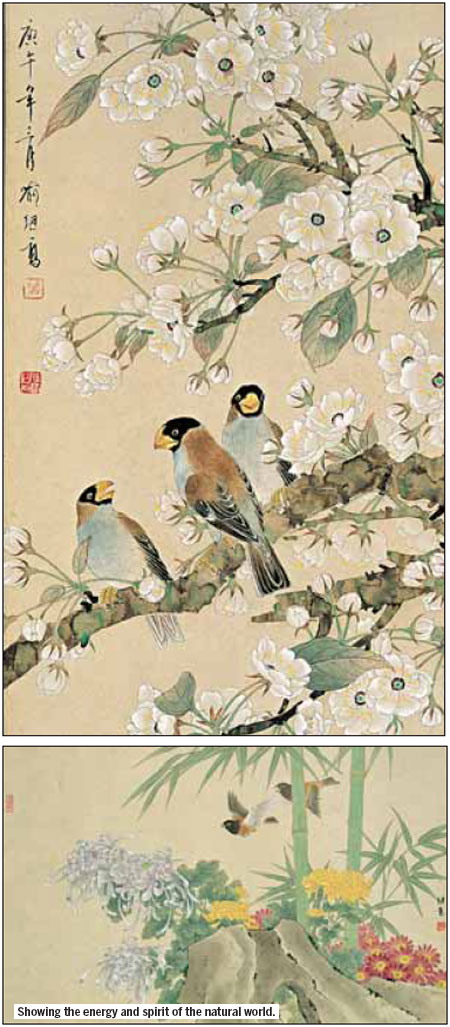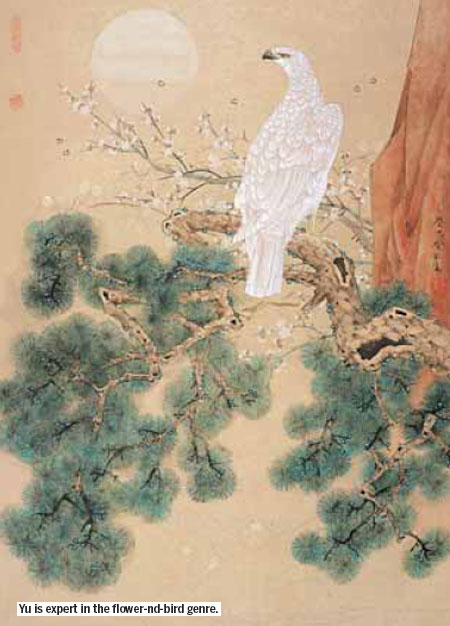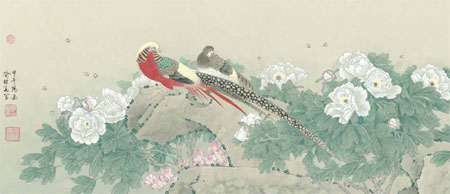Brush with beauty
Updated: 2014-03-09 07:50
By Huang liying(China Daily)
|
|||||||||
Yu Jigao brings spirit and emotion to traditional realism
Traditional wisdom holds that gongbi and xieyi, two distinct approaches to Chinese traditional flower-and-bird painting, can never be mixed.
But Yu Jigao, a gongbi painter from Jiangsu province, is breaking the stereotype.
He contends the two styles actually share the same spirit since they are rooted in Chinese culture and philosophies.
"I can convey the xieyi spirit through my gongbi artwork", he said.
Known for its expressive style, xieyi painting is characterized by freehand brushwork.
It was favored by ancient literati to express their emotions and personal feelings through art.
In contrast, gongbi style is realistic. It requires neat brushwork and close attention to detail.
"Some may say that gongbi focuses on resemblance and colors, so it is not as expressive as xieyi, and it lacks charm and spirit. This is not true," Yu said.
Despite difference in styles and approaches, artists can always compose artwork that possess spirit as long as they put their heart into the painting and have an urge to deliver their true feelings, he said.
Traditionally, xieyi painters do not focus on the likeness of the object. Instead they turn the painting process into a meditation.
They emphasize catching the rhythm, dynamic movement and nuances of objects, making them integrate with the universe - the reason many believe xieyi perfectly reflects the spirit of Chinese culture.
In addition, many xieyi painters are excellent calligraphers because the two art forms are closely linked.
But it is not the only style that can express emotions and understanding of nature, Yu said.
Gongbi, which flourished during Tang dynasty (618-907), has a long history and deep roots in Chinese culture as well.
"Both form and spirit are important factors in Chinese traditional paintings. The detailed and concrete forms of objects in gongbi painting are not preventing, but helping, artists express their ideas and spirit," Yu said.
Both styles pursue "the most advanced stage in Chinese art - combining the realms of heaven and humans together", he added.
"Despite different approaches, every painter is a poet. We create things and give them meaning."
Although Yu is a gongbi painter, he never paints birds and flowers as exactly as they look.
He reconstructs them and creates an artistic world that enables him to deliver his feelings and spirit to viewers.
One of his representative works, Ode to White Herons, aims to present his cheerfulness toward life.
With long legs and white features, some herons hide behind plants while others wander along a stream.
They give people a relaxing and free feeling, Yu said.
Morning fog and reeds on the riverside are also carefully depicted, making the painting more real and lifelike.
In the distance, the sun is rising, symbolizing hope and happiness.
The painting filled with Chinese traditional elements precisely describes a beautiful natural scene while conveying the mood and emotions of the artist.
"I puts my energy, sense, emotions and thoughts together into my painting to create an ideal artistic world," Yu said.
Another representative work, Spring Comes to Every Corner of the World, presents the vitality and beauty of awakening nature.
Flowers are blooming in the spring breeze as butterflies and bees dancing around.
Yu said he tries to cherish life through depicting beautiful nature.
"Pan Jiezi (1915-2002), a renowned gongbi painter, once said that the two styles have the same spiritual essence," Yu said
"I agree with his conclusion - gongbi's meticulous brushworks does not equal to 'flat and plain'. In the contrast, they make free expression possible", he added.
huangliying@chinadaily.com.cn
|
Gongbi style, which requires neat brushwork and close attention to detail, flourished during Tang dynasty (618-907). provided to China Daily |



(China Daily 03/09/2014 page7)
